Somalia: Images
of Dry Tropical Habitat
Most of these images were taken by plant collector Frank Horwood, who
visited Somalia several times. Somalia is one of the very special parts
of the dry tropics. It is a vast expanse of seasonally arid land very close
to the equator. Though it is dry and often referred to as desert, Somalia
instead has a very rich tropical flora. The rainy season can often be severe
in places and sometimes accompanied by tragic flooding or, by disease outbreaks
as reportedin a Kenyan headline in early 1998
(the outbreak turned out to be Rift Valley Fever).
Click on a thumbnail for a larger image:
Plants
1.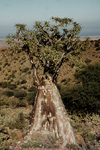 2.
2.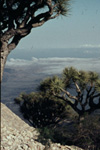 3.
3.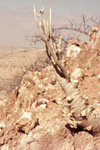 4.
4.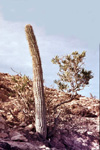
1. Adenium obesum (A. somalense), a bottle tree in the Oleander Family
photographed near Las Gorey in northern Somalia. The Gulf of Aden is visible
in the background.
2. The fantastic forms of Dracaena trees (Dracaenaceae) near Cal Madow
in northern Somalia, in the mountains above the area of the previous photo.
The ocean is still visible in the distance.
3. View of the calcareous landscape near Las Anod in the central part
of northern Somalia. The thick plant is Dorstenia gypsophila, a member
of the Fig Family (Moraceae). Most Dorstenias are small herbs; this species
is a giant in the genus.
4. Euphorbia columnaris (Euphorbiaceae) near Las Anod. This unbranched
species is only known from a small part of northern Somalia.
5.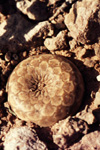 6.
6.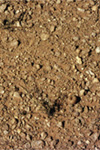 7.
7.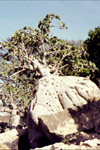 8.
8.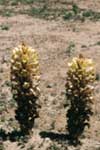
5. and 6. Another narrow endemic Euphorbia, E. turbiniformis, found
only in a small part of northeastern Somalia. Try to find 3 Euphorbia turbiniformis
plants in photo 6. Click here to see
a huge box of this species dug from the wild. In his journal, Horwood estimates
that he and colleagues removed 3,000 plants from habitat. It isn't clear
how large the original population was or what effect the removal of so many
plants has had on the species.
7. The monstrous mounds of Pyrenacantha malvifolia (Icacinaceae) resemble
huge boulders.
8. Flowers of the parasitic broomrape Cistanche tinctoria (Orobanchaceae).
9.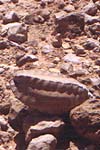 10.
10.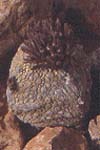 11.
11.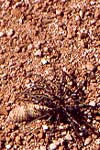 12.
12.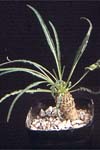
9. The strange succulent milkweed Whitesloanea crassa (Asclepiadaceae)
growing in northern Somalia. This plant is thought to be very rare, because
individuals are found growing very far apart from one another and never
in large populations. Despite its apparent rarity, succulent enthusiasts
seem to dig up every specimen they find.
10. Another very strange succulent milkweed, Pseudolithos migiurtinus,
also from northern Somalia.
11. Notice how inconspicuous this small Euphorbia species (Euphorbiaceae)
is in this photograph from its wild habitat in northern Somalia.
12. The plant on the left is the same species shown in 11. in cultivation.
Animals
1.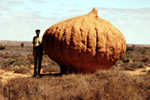 2.
2.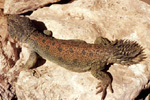 3.
3.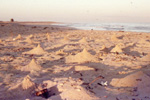
1. An enormous onion-shaped termite mound with a Somali policeman, between
Gardo and Iskushuban.
2. Spiny-tailed Uromastyx princeps in northeastern Somalia.
3. Incredible city of castles built by crabs on a beach near Eil, northeastern
Somalia.
Landscapes
1.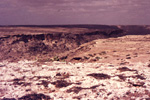 2.
2.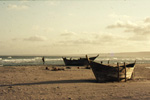 3.
3.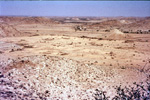
1. A view of the Nogal Valley near Eil.
2. Dhows on a beach near Eil.
3. Arid landscape near Las Anod in the Nogal Valley of northern Somalia.
home - people -
research - images of the
dry tropics - exploration
- acknowledgements
Instituto
de Biología, Universidad Nacional Autónoma
de México
Circuito Exterior s/n, Ciudad Universitaria
Copilco, Coyoacán A. P. 70-367
C. P. 04510, México, D. F.
MÉXICO
(52)
55 5622-9127 fon (52) 55 5555-1760 fax
molson@ibiologia.unam.mx
all
material © 2002 Mark E Olson
 2.
2. 3.
3. 4.
4.
 6.
6. 7.
7. 8.
8.
 10.
10. 11.
11. 12.
12.
 2.
2. 3.
3.
 2.
2. 3.
3.